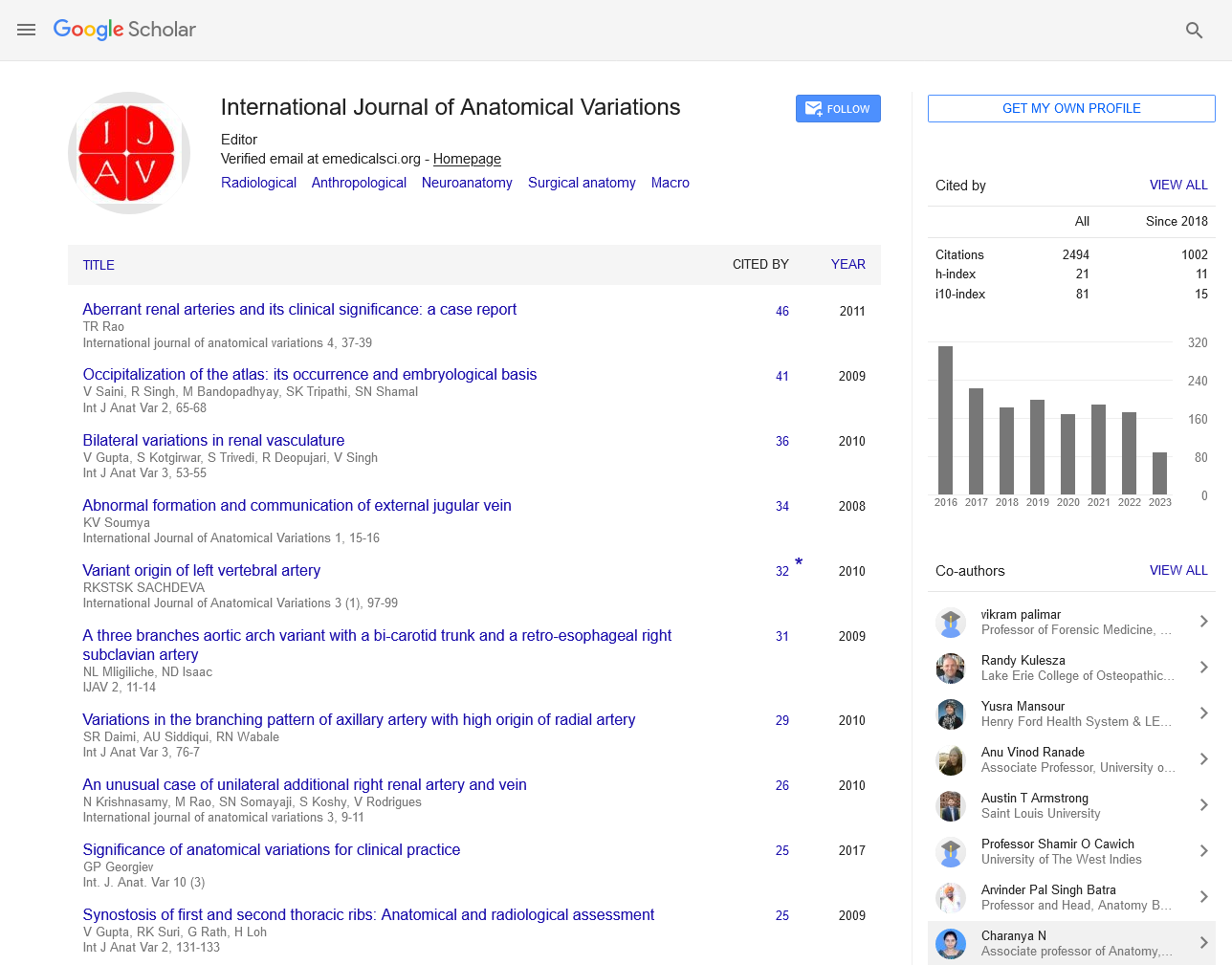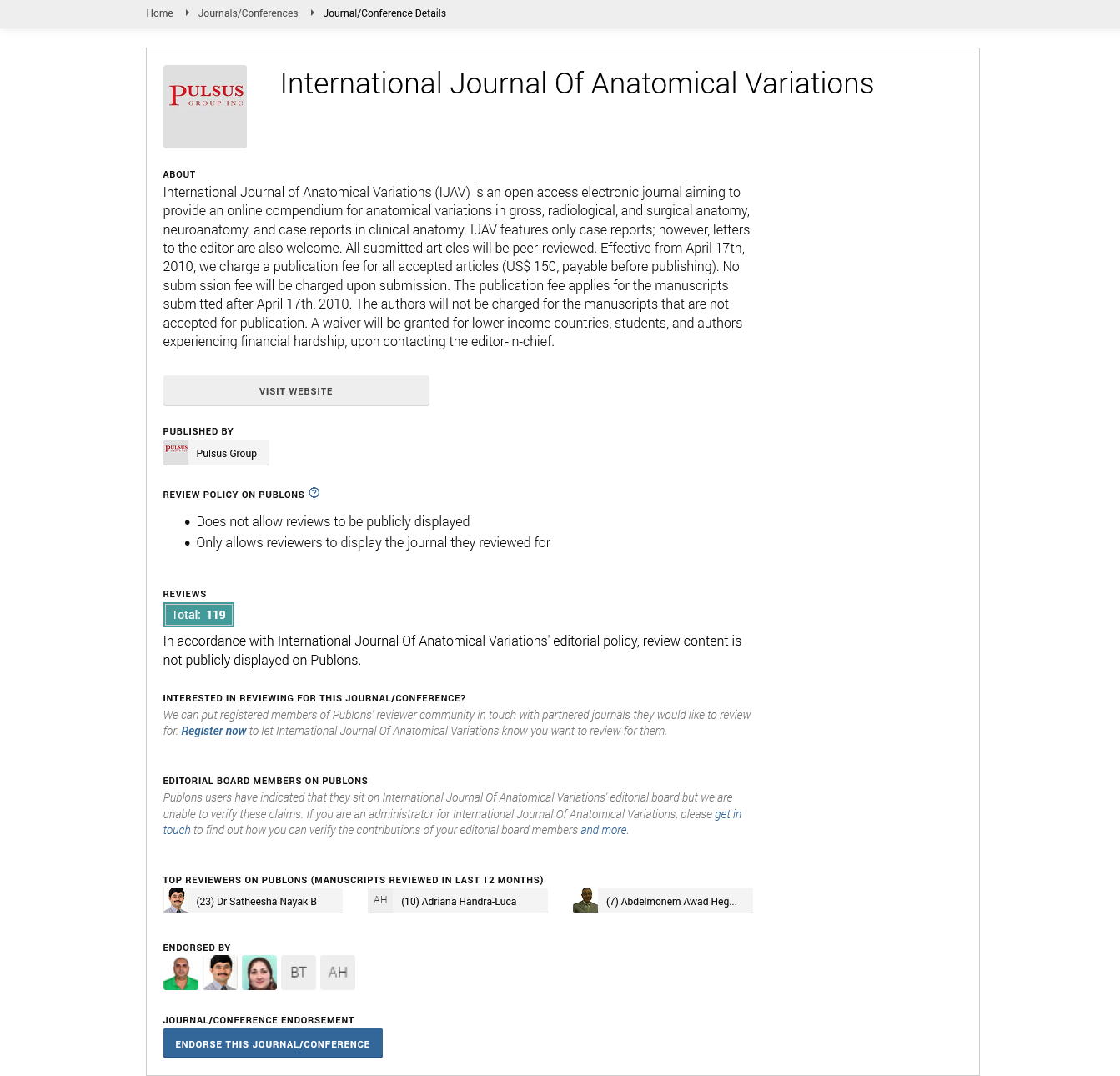Anomalous Distribution of the Maxillary Nerve: Clinical Considerations for Trigeminal Neuralgia Treatment
Received: 02-Jan-2025, Manuscript No. ijav-25-7543; Editor assigned: 04-Jan-2025, Pre QC No. ijav-25-7543 (PQ); Reviewed: 18-Jan-2025 QC No. ijav-25-7543; Revised: 24-Jan-2025, Manuscript No. ijav-25-7543 (R); Published: 31-Jan-2025, DOI: 10.37532/1308-4038.18(1).475
Citation: Prakash R. Anomalous Distribution of the Maxillary Nerve Clinical Considerations for Trigeminal Neuralgia Treatment. Int J Anat Var. 2025;18(1): 719-720.
This open-access article is distributed under the terms of the Creative Commons Attribution Non-Commercial License (CC BY-NC) (http://creativecommons.org/licenses/by-nc/4.0/), which permits reuse, distribution and reproduction of the article, provided that the original work is properly cited and the reuse is restricted to noncommercial purposes. For commercial reuse, contact reprints@pulsus.com
INTRODUCTION
The maxillary nerve (V2) is the second branch of the trigeminal nerve (CN V) and plays a crucial role in the sensory innervation of the midface, including the skin, mucosa, and sinuses. Trigeminal neuralgia (TN), a disorder characterized by sudden, severe, and stabbing pain along the distribution of one or more branches of the trigeminal nerve, can result from various anatomical anomalies of the nerve. Although the condition most commonly affects the ophthalmic and mandibular branches, the maxillary nerve can also be involved, either through direct compression or anomalous anatomical variations. Understanding the implications of these anomalous distributions of the maxillary nerve is critical in the effective diagnosis and management of trigeminal neuralgia. This article explores the anatomical variations of the maxillary nerve, their association with trigeminal neuralgia, and the clinical considerations for treatment [1].
ANATOMY AND FUNCTION OF THE MAXILLARY NERVE
The maxillary nerve, which originates from the trigeminal ganglion, supplies sensation to the midface region, including the maxillary sinuses, upper teeth, palate, nasal cavity, and skin of the cheek. It enters the pterygopalatine fossa through the foramen rotundum, giving rise to several branches that innervate these regions. The function of the maxillary nerve is primarily sensory, transmitting pain, touch, and temperature sensations from the areas it supplies. The normal course of the maxillary nerve involves its passage through the foramen rotundum, its entry into the pterygopalatine fossa, and the subsequent branching into the infraorbital nerve, greater and lesser palatine nerves, and other branches. These branches provide sensory innervation to a wide range of facial structures, including the skin of the upper lip, cheek, and nose, as well as the mucosa of the upper oral cavity [2].
ANOMALOUS DISTRIBUTION OF THE MAXILLARY NERVEGYNECOID PELVIS
Anomalous distributions of the maxillary nerve can occur in a variety of forms, often due to developmental variations, trauma, or pathological conditions. These anomalies can alter the normal sensory distribution of the nerve, leading to atypical patterns of pain and sensory deficits, which are important to consider in the diagnosis and treatment of trigeminal neuralgia. One of the most common variations involves accessory branches from the maxillary nerve, which may innervate areas typically supplied by the ophthalmic or mandibular branches. These accessory branches can result in pain in areas that are not typically affected by trigeminal neuralgia. Additionally, the course of the maxillary nerve may also be altered in certain individuals, such as cases where the nerve passes through the skull base at different angles or through unusual openings. These variations can contribute to abnormal compression or irritation of the nerve, potentially leading to trigeminal neuralgia symptoms. In some individuals, the maxillary nerve may have a more distal distribution, innervating regions such as the lower eyelid or the lateral side of the nose, which are usually supplied by the ophthalmic nerve (V1). This variation can complicate the diagnosis of TN, as it may mimic symptoms of other facial pain disorders.
CLINICAL IMPLICATIONS OF ANOMALOUS MAXILLARY NERVE DISTRIBUTION IN TRIGEMINAL NEURALGIA
Anomalous distributions of the maxillary nerve can complicate the clinical presentation of trigeminal neuralgia, as the pain may involve atypical locations not typically seen in classical TN. The distribution of pain may extend beyond the traditional areas supplied by the maxillary branch, making diagnosis more challenging. For example, patients with anomalous distributions may experience pain in the lower eyelid or the lateral aspects of the nose, which can lead to confusion with other neuropathic conditions or facial pain syndromes. The key clinical implication of these anatomical variations is that they can alter the sites of nerve compression or irritation, often resulting in symptoms that are harder to localize. Compression of the maxillary nerve may occur at atypical locations, such as within the pterygopalatine fossa or near the foramen rotundum, causing symptoms not typically seen in more conventional forms of trigeminal neuralgia [3]. This can impact the efficacy of treatments aimed at addressing nerve compression, such as microvascular decompression (MVD), which is typically used for TN involving the ophthalmic or mandibular branches. Additionally, the involvement of accessory or aberrant branches can result in the need for more precise diagnostic imaging to identify the exact location of the anatomical anomaly. High-resolution MRI and neuroimaging techniques can help map the course of the maxillary nerve and detect any compression or other structural abnormalities contributing to the pain.
DIAGNOSTIC APPROACHES TO ANOMALOUS MAXILLARY NERVE DISTRIBUTION IN TN
Diagnosing trigeminal neuralgia caused by anomalies in the maxillary nerve requires careful consideration of both clinical presentation and imaging studies. The atypical locations of pain associated with maxillary nerve anomalies often necessitate a thorough clinical evaluation, with a focus on ruling out other causes of facial pain, such as sinusitis, dental issues, or temporal arteritis. MRI with contrast enhancement is the gold standard for assessing vascular compression of the trigeminal nerve. For patients with suspected maxillary nerve involvement, the imaging may reveal anomalies such as abnormal vascular loops, nerve tethering, or compression at unusual points along the nerve’s path. Additionally, 3D reconstructions of the trigeminal nerve and its branches may help in identifying the location and cause of compression or irritation. CT scans may also be useful in cases where the anatomical distribution of the nerve is highly variable or complex, as they provide additional insight into bone structures that may contribute to nerve compression [4].
TREATMENT CONSIDERATIONS FOR TRIGEMINAL NEURALGIA WITH MAXILLARY NERVE INVOLVEMENT
The treatment of trigeminal neuralgia associated with anomalous distribution of the maxillary nerve is similar to that for more typical forms of TN, but with added complexities due to the variations in nerve anatomy. Initial management typically involves medication to reduce pain and control symptoms. Anticonvulsants, such as carbamazepine, oxcarbazepine, or gabapentin, are the mainstay of treatment. These medications help control the hyperexcitability of the trigeminal nerve and alleviate pain. For patients who do not respond to pharmacological therapy, more invasive options may be considered. Microvascular decompression (MVD) remains a widely used procedure for patients with TN resulting from vascular compression of the nerve. However, in cases involving anomalous distributions of the maxillary nerve, MVD may be more challenging due to the atypical location of the compression. In such cases, radiofrequency ablation or percutaneous glycerol rhizotomy may be alternative options. Another treatment approach is the use of Gamma Knife radiosurgery, which can target the nerve at the point of compression or irritation. This non-invasive method can be especially helpful in cases where the nerve’s abnormal course complicates surgical intervention [5].
CONCLUSION
The anomalous distribution of the maxillary nerve plays a crucial role in the pathophysiology of trigeminal neuralgia, particularly when these variations lead to atypical pain patterns or nerve compression. Understanding the anatomy of the maxillary nerve and its potential variations is critical for accurate diagnosis and effective treatment. Clinicians must consider these variations when diagnosing trigeminal neuralgia and selecting appropriate treatment strategies, as these anomalies can complicate both conservative and surgical approaches. Advanced imaging techniques such as high-resolution MRI are essential for identifying these variations and guiding treatment decisions. By recognizing the clinical implications of maxillary nerve anomalies, healthcare providers can better address the complexities of trigeminal neuralgia and improve patient outcomes.
REFERENCES
- Fontana F, Coppola A, Ferrario L. Internal Iliac Artery Embolization within EVAR Procedure: Safety, Feasibility, and Outcome. J Clin Med. 2022; 11(24):73-99.
- Park K-M, Yang S-S, Kim Y-W, Park KB, Park HS, et al. Clinical outcomes after internal iliac artery embolization prior to endovascular aortic aneurysm repair. Surg Today 2014; 44:472-477.
- Rayt HS, Bown MJ, Lambert KV. Buttock claudication and erectile dysfunction after internal iliac artery embolization in patients prior to endovascular aortic aneurysm repair. Cardiovasc Intervent Radiol. 2008; 31(4):728-34.
- Patel SD, Perera A, Law N, Mandumula S. A novel approach to the management of a ruptured Type II endoleak following endovascular repair of an internal iliac artery aneurysm. Br J Radiol. 2011; 84(1008):e240-2.
- Szymczak M, Krupa P, Oszkinis G, Majchrzycki M. Gait pattern in patients with peripheral artery disease. BMC Geriatrics. 2018; 18:52.
Indexed at, Google Scholar, Crossref
Indexed at, Google Scholar, Crossref
Indexed at, Google Scholar, Crossref
Indexed at, Google Scholar, Crossref






